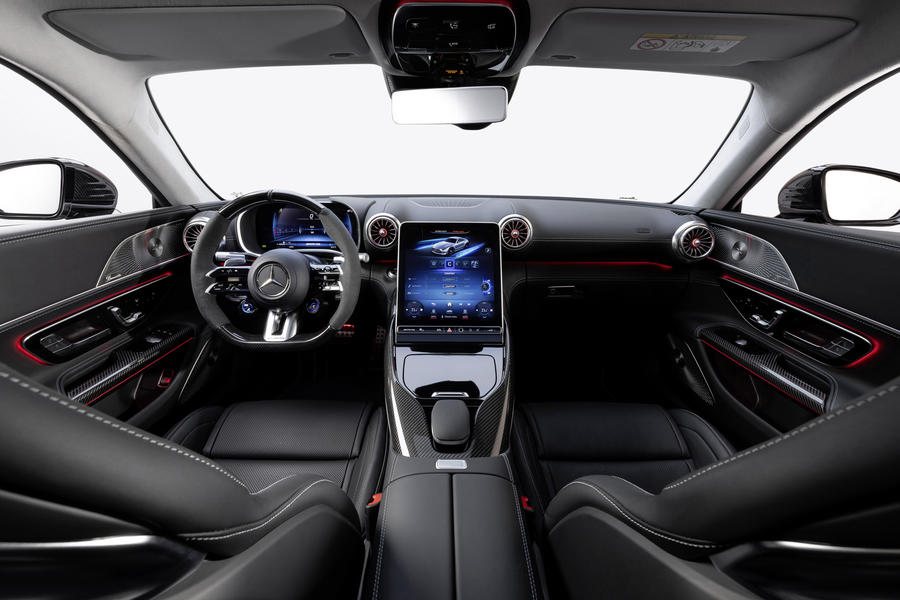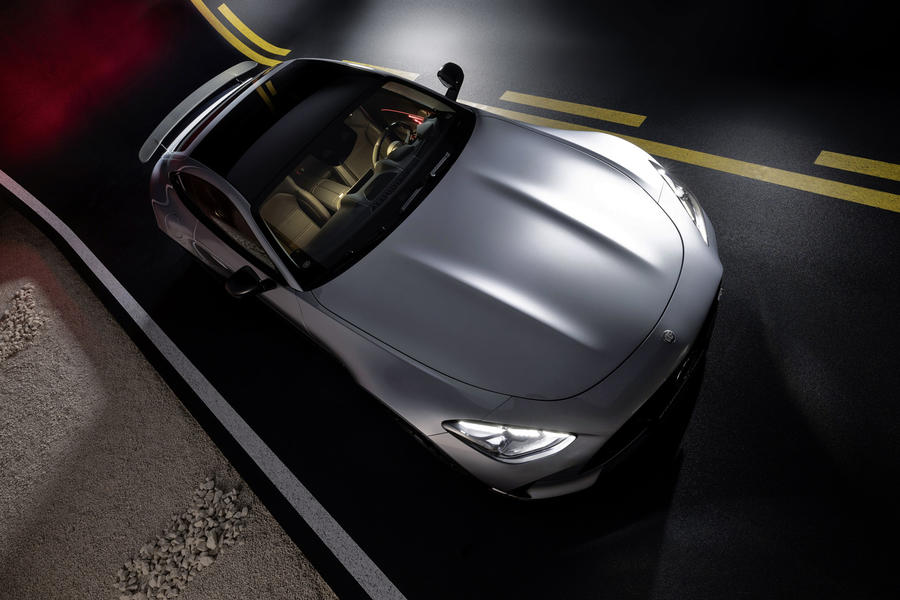New Mercedes-AMG GT E Performance is all but identical to pure-V8 GT 63
Just weeks after revealing new second-generation GT, AMG has quietly shown PHEV version in Munich
Mercedes-AMG has quietly used the Munich motor show to preview the upcoming plug-in hybrid version of its new second-generation GT sports coupé.
On display in a light camouflage just two weeks after the debut of the standard GT 63, the super-PHEV is primed for a launch in the coming months as a two-door alternative to the GT 63 S E Performance 4-Door Coupé super-saloon.
At this stage, the only evidence of the prototype’s electrified innards is a charging port integrated into the rear bumper. Otherwise, it looks all but identical to the standard, ICE-only GT.
Indeed, it’s set to be powered principally by the same 4.0-litre twin-turbocharged V8 engine but paired with an electric motor for a significant power boost.
The four-door GT PHEV uses a 201bhp motor on the rear axle to increase total system output to 831bhp, making it AMG’s most powerful series-production car to date.
The similarly equipped Mercedes-AMG S63 E Performance is detuned slightly to give 791bhp.

The two-door GT PHEV will use a similar system, although AMG is keeping specifics under wraps at this stage. It’s also not known if it uses the four-door GT’s 4.8kWh battery, the S63’s 13.1kWh battery or another battery entirely.
Either way, the PHEV version of the new GT looks set to be the most powerful variant in the line-up, likely with power figures that eclipse even the extreme GT Black Series of the previous generation.
Further details are expected to be revealed as the car nears its full unveiling in the coming months.
Revealing AMG’s renewed rival for the Aston Martin Vantage and Porsche 911 in Pebble Beach last month, company CEO Michael Schiebe said the second-generation GT had been designed to “respond to the wishes of customers”.
The new GT has been comprehensively re-engineered in a programme that has seen its development twinned with that of the latest SL, alongside which it will be produced at the Mercedes-Benz‘s factory in Bremen, Germany.
Larger and heavier but also roomier and arguably more practical than its predecessor, it forgoes the two-seat layout that has characterised the top-of-the-line AMG model since its introduction in 2014, for a two-plus-two interior design that, in combination with a larger and more accessible boot, aims to provide it with greater everyday functionality.
As with the closely related SL, the GT adopts a fully-variable four-wheel drive system as standard for the first time. It replaces the rear-wheel drive arrangement used previously, providing the new coupé with what Schiebe describes as “a much broader spread of driving characteristics, together with greater traction and added security in all weather conditions”.
The fifth series-production road car to be developed ground-up by AMG will initially be sold in a choice of two guises – both featuring the company’s hand-assembled, twin-turbocharged 4.0-litre V8 petrol engine. The new GT 55 4Matic+ develops 469bhp and 516lb ft of torque, with the range-topping GT 63 4Matic+ offering 577bhp and 590lb ft – both upgrades over the equivalent versions of the first-gen GT.

The 55 is expected to open the line-up at around £150,000, with the 63 bumping that up to nearer £180,000, based on prices for the soft-top SL, which will make them close rivals for the Porsche 911 Turbo and Turbo S, respectively. There’s no word yet on whether the GT will get the four-cylinder entry-level option from the SL 43, but its more ‘hardcore’ billing could see it remain a V8-only proposition.
The updated engine, which Schiebe says will be made compliant with Euro 7 emission compliance when required, operates in combination with a nine-speed AMG Speedshift automatic gearbox featuring a wet “starter” clutch in place of a conventional torque converter. Mounted directly to the end of the reworked V8, it replaces the earlier GT’s seven-speed dual-clutch transaxle unit, which was sited within the rear axle assembly. Also included is an electronically-controlled rear-locking differential.
Despite differing specifications, Mercedes-AMG quotes the same 1970kg kerb weight for both of its new GT models. The 55 claims an official 0-62mph time of 3.9sec and a 183mph top speed, while the 63 offers a respective 3.2sec and 196mph, it says.
Average fuel consumption is put at 20.0mpg for both models for combined CO2 emissions of 319g/km on the WLTP test cycle.
The basis for the GT is a newly developed body structure shared with the SL. It uses a material mix consisting of aluminium, composite fibre materials, magnesium and steel.

The styling draws heavily on the first-generation model, with a traditional cab-back profile dictated by a long bonnet, curved roofline and angled liftback tailgate.
Among the aerodynamic developments is a so-called “active air control system” within the grille to alter the flow of air to the engine bay, a carbonfibre element within the underbody which lowers by 40mm to create a wind-cheating Venturi effect and a retractable rear spoiler that automatically deploys at 50mph and offers up to five different wing angle positions.
Buyers can also option the new GT with an aerodynamic package. It includes small winglets on the outer sections of the front bumper and wheel arches, as well as a fixed rear wing.
Both the 55 and the 63 roll on standard 20in wheels, shod with 295/35 (front) and 305/35 (rear) profile tyres. 21-inch wheels are available as an option.
At 4728mm in length, 1984mm in width and 1354mm in height, the new coupe is 182mm longer, 45mm wider and 66mm higher than the first-generation GT. It also has a wheelbase that is 70mm longer than before, at 2700mm.
With the SL taking the role of the earlier GT roadster, the new GT will be produced exclusively in coupé guise, with a near-identical cockpit to its soft-top sibling.
Included among the digital appointments is a 12.3in instrument panel and 11.9in portrait-oriented infotainment display – both featuring AMG-specific graphics and menus, including a standard AMG Track Pace function that allows the driver to display up to 40 different vehicle parameters, including lap and sector times, steering angle, brake pedal actuation.

The new GT also receives an AMG Performance steering wheel and sculptured front sport seats with integrated headrests – the latter available with optional ventilation and automatically actuated side bolsters that narrow in the Sport, Sport+ and Race driving modes.
The new individual rear seats are limited in leg and headroom and are suitable for children only. They can be folded down to extend the nominal 321 litres of boot space underneath the cargo blind to up to 675 litres. By comparison, the old GT offered 285 litres, while the SL offers 213 litres.
The GT receives new aluminium double-wishbone AMG Active Ride Control suspension. It uses constantly variable electronic damping, steel coil springs and active roll stabilisation with hydraulic elements in place of conventional anti-roll bars to suppress body roll. Buyers can order an optional lift system offering an added 30mm of ground clearance.
The new coupé also adopts four-wheel steering as standard, with the rear wheels offering up to 2.5 degrees of steering angle. The brakes combine 390mm steel discs with six-piston aluminium callipers up front with 360mm steel discs and single piston floating aluminium callipers at the rear.
A new AMG Dynamic Select controller offers the driver the choice of six driving modes – Slippery, Comfort, Sport, Sport+ and Race – and the AMG Dynamics ESC system allows the driver to alter the level of intervention across three steps.
Mercedes-AMG GT first ride
Mercedes-AMG promises the new GT will be an old-school AMG, staying true to many of the brand’s traditional values and something that resonates strongly with enthusiasts. Speculation has only grown since AMG announced the new C192-generation model would be twinned with the latest SL.
So to find out if the 2023 car will be bigger and heavier, have its performance and character bound by ever-stricter emissions regulations and, perhaps, become less focused than the original, Autocar joined AMG’s new CEO, Michael Schiebe, for a ride in a near-finished prototype.
“Before you ask, we’re only going to build it as a coupé,” he said, immediately.
“There is no shame in it sharing its DNA with the SL, which takes the roadster role in our portfolio.” The two AMG cars are based on the same Modular Sport Architecture platform, a lightweight spaceframe-style structure that uses a combination of aluminium, steel, magnesium and plastic composites.
Schiebe said the new GT will be more rigid than the SL, which is to be expected, given that it has a fixed roof and other additional stiffening measures, including substantial engine bay bracing.
Dimensionally, the new GT has grown. Official details have not yet been released, but we expect it to mirror the latest SL with a length of around 4705mm – 159mm longer than the old model.

The wheelbase has increased by 70mm to 2700mm too, and the interior (identical to the SL’s) has been repackaged, which provides the scope for a set of rear seats and a larger boot.
“The feedback we got from customers was to keep the performance but broaden the scope to make it a more amicable car in everyday driving conditions. We’ve got people who use the GT for weekend trips and longer,” said Schiebe.
At launch, cars will use AMG’s twin-turbocharged 4.0-litre V8 engine. Schiebe would not go into detail yet but said it has been engineered with Euro 7 emissions regulations in mind. He also hinted at electrified models further down the line: “They are not planned from the beginning but we’re well prepared to bring them online when the regulatory framework demands it.”
Will the new GT line-up encompass as many models as its predecessor, which, at last count, ran to 11? “Wait and see,” said Schiebe, adding: “We already offer the SL in 43, 55 and 63 models.” In a development brought to the SL, the previous Speedshift MCT seven-speed dual-clutch transaxle of the first-generation GT is replaced by a nine-speed gearbox mounted directly to the engine.

As before, it offers both manual and automatic shifting. However, new for 2023 will be a fully variable four-wheel drive system in place of the traditional rear-wheel drive.
Noticeable from the passenger seat is just how close the new model feels to the original. Despite larger dimensions, a more spacious interior and a heavily reworked drivetrain, it still feels like a GT.
There is the same deep staccato engine sound, the same elongated view down the bonnet and the same exuberant accelerative force under load in Sport Plus mode.
It is traditionally AMG in character. Schiebe admitted the larger dimensions, the new interior layout and the addition of four-wheel drive have inevitably increased weight. He’s confident, however, that the new GT is every bit as dynamically adept as its predecessor, if not more so.
He said the decision to go with four-wheel drive opens up a new dimension for the GT. “We have a fully variable apportioning of power front to rear. That means that you can not only decide to drive to the Alps in June or July, but also in October or November, because you feel safe,” he said.
The double-wishbone front and multi-link rear suspension, with variable damping control and active anti-roll functions, is uniquely tuned. The new GT is firmer than the SL, but it gives the impression that it delivers greater compliance and better absorption of road shock than the original model.
On the way back to AMG’s HQ in Affalterbach over undulating country roads, Schiebe identified what he believes to be the defining characteristics of the company’s new flagship. “It is still a supercar with an ability to excite and engage the driver on a very high level,” he said. “But it now has greater comfort and ease of use. It is a more agreeable car on an everyday basis.”
Source: Autocar
